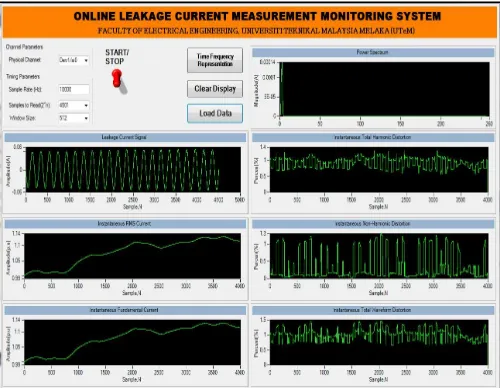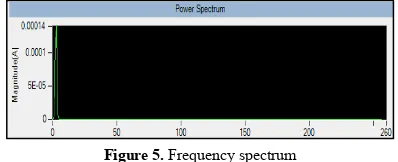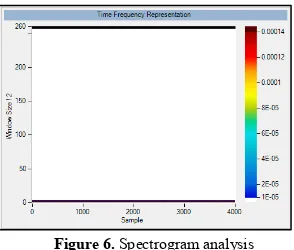Abstract— Insulations in high voltage engineering are a concern to users in terms of its performance, expected lifetime, and long-time reliability. Insulation failure can allow leakage current (LC) to flow and causes tracking and erosion as well as flashover. Tracking and erosion test complying with BS EN 60857-2007 are conducted to capture the set of leakage current (LC) patterns which are capacitive, resistive, and discharge activities. For verifying the performance of the insulators, an automated monitoring system is needed to reduce diagnostic time of the LC. Even though Fast Fourier Transform (FFT) gives useful information on the analysis of LC, it has limitation in non-stationary signal. Therefore, this research presents the analysis of time frequency distribution (TFD) which is spectrogram that represents the LC signals in the joint time frequency domains which provide temporal and spectral information. The results obtained from the developed monitoring system allow the user to identify leakage current performance in real time. The developed system has shown the capability in detecting the performance of insulating materials as well as identifying the characteristics of the surface discharges.
Index Terms--Leakage current, monitoring, spectrogram I. INTRODUCTION
IGH voltage insulators are widely used in power industry and it is the most important part to prevent the flow of current to undesired paths and to resist stresses (mechanical stresses, electrical stresses, and environmental stresses)[1]. The insulators of the power system lines are easily exposed to the effects of pollution such the open air that causes tracking and erosion as well as to flashover[2]. Leakage current (LC) signal is a tool that leads to these contaminated conditions. Measurement of LC can be an effective method for minimizing the pollution flashover of insulators, and better if requires additional information from measurements and analysis of the pollution[3]. Tracking and erosion test complying with BS EN 60587-2007 are conducted on existing materials, which leakage current frequency components is used as a diagnostic tool for their surface condition monitoring and degradation severity.
Online performance monitoring can benefits engineering industries by confirming if the materials/equipment is performing as desired by the user. Online monitoring can give instantly information on LC performance in terms of its harmonic components. Normal performance analyses are usually conducted in offline mode which the LC data is saved into other files to be analyzed later. LC parameters such RMS value, RMS fundamental value, total harmonic distortion, total
non-harmonic distortion, and total wave distortion instantaneously is estimated in order to develop and monitoring state condition of the materials insulating condition.
LC is normally analysed in frequency domain that utilise Fast Fourier Transform (FFT) for transformation technique[4]. However, this technique is only suitable for stationary signals and does not provide temporal information[5]. Therefore, technique of Time-Frequency Distribution (TFD) is used that represent the signal in time and frequency which provide temporal and spectral information[6]. This study use spectrogram as Time-Frequency Distribution (TFD) analysis technique to extract information on LC.
LC is classified into groups namely capacitive, resistive, and non-linear[7]. The aim of this study is to examine the reliable method of surface monitoring using LC signal in time-frequency domain. Spectrogram is performed to analyze the surface condition of insulation material. Incline Plane Test (IPT) that complying with BS EN 60578-2007 is conducted on Polypropylene polymeric composite to simulate a set of different LC patterns as stated above.
The online LC monitoring system shows the performance of LC in time domain, FFT, spectrogram, root mean square (RMS) value, fundamental value, total harmonic distortion (THD), total non-harmonic distortion (TnHD), and total wave distortion (TWD). The percentage of total waveform distortion TWD is applied as rule based value for surface classification purpose.
II. EXPERIMENTAL WORK
Inclined Plane Test (IPT) is normally used to evaluate the tracking and erosion resistance of insulating materials and recommended by BS EN 60587[8]. It is a valuable tool for the comparison and evaluation of new and different materials under controlled electrical stress, to compare the suitability of materials for the dielectric surface of an insulator. It also has simplicity in test procedure and low equipment cost, and Polypropylene is used as the material under test. The selection of Polypropylene as electrical insulation, their advantages and properties are mentioned in [9]. Fig. 1 shows the experiment setup for IPT. The captured LC signal is based on NI-DAQ (data acquisition) that connected between the experimental high voltage setup and the notebook or computer to link with the software. The input signal is connected parallel with resistor to obtain the LC that flowed from the high voltage system. The LC signal and the analysis of the signal are
H
Online Surface Condition Monitoring System
using Time-Frequency Analysis Technique on
High Voltage Insulators
N. Q. Zainal Abidin, A. R. Abdullah, N. H. Rahim, N. Norddin and A. Aman
Faculty of Electrical Engineering,displayed on the monitoring system.
In this study, Method 2 ‘variable-voltage method’ or stepwise tracking voltage is applied to simulate the initial and continuous tracking voltage as well as surface condition events for sample specimen. The voltage is increased from 0-3.5kV while maintaining the conductivity level of 2.5mS/cm and flow rate at 0.3ml/min.
Figure 1. Experiment setup for IPT test
The LC flow on polymer insulation surface can be divided into several parts which are the early aging period (EAP), transition period (TP) and late aging period (LAP) [10]. It consists of capacitive current, resistive current, non-linear current and non-linear with discharge current [11], which is the basic concept of this study. When the sample is completely dry or in hydrophobic state it is classified as EAP and only low capacitive LC flowed. In the second state, TP, the polymer insulation surface became hydrophilic and LC will change significantly from capacitive to resistively. Finally, during the LAP, LC is completely resistive and surface discharge took place.
III. LEAKAGE CURRENT ANALYSIS
Graphical user interface (GUI) using visual basic is developed to capture LC signal for monitoring and analysis purpose. The analysis of the LC signal includes FFT, spectrogram, and harmonic components such THD, TnHD, and TWD as shown in Fig. 2.
Figure 2. Leakage current monitoring system
A. Analysis in Frequency Domain
Fourier transform (FT) is mathematical techniques which convert signal from time to frequency domain. It can be defined as:
where f is the frequency to be analyzed. Discrete Fourier transform (DFT) is a digital filtering algorithm that calculates the magnitude and phase at discrete frequencies of a discrete time sequence while Fast Fourier Transform (FFT) are computationally capable algorithms for computing the DFT. The DFT is defined as:
where N is the maximum number of samples.
B. Analysis in Time-Frequency Representation
Instead of using frequency domain analysis, spectrogram gives better information on the material surface condition. The state of events from EAP to LAP can be classified by observing the result of spectrogram analysis. Other observations are the length, type of window and frequency sampling that is used has affected the frequency resolution as well as time resolution of spectrogram results.
Spectrogram is one of the time-frequency distributions (TFD) that represents the signal energy with respect to time and frequency. The analysis technique is motivated by the limitation of FFT to cater non-stationary signals whose spectral characteristics change in time. The changes are from calculating of the frequency spectrum of compound signal windowed frames [12]. Spectrogram can be defined as:
2
A. Instantaneous RMS Current
The instantaneous RMS current is the square root of the arithmetic mean of squares of the function of continuous waveform. It can define as:
∫
where Sx(t,f) is the time-frequency representation and fmax is
the maximum frequency of interest.
B. Instantaneous RMS Fundamental Current
Instantaneous RMS fundamental current, I1rms(t) is defined as
2
where f1 is the fundamental frequency that corresponds to the
power system frequency and Δf is the bandwidth which is set to 50Hz.
C. Instantaneous Total Harmonic Distortion
Total harmonic distortion (THD) is the relative signal energy present at non-fundamental frequencies and written as:
)
where Ih,RMS(t) is instantaneous RMS harmonic current and H is
the highest measured harmonic component.
D. Instantaneous Total non-Harmonic Distortion
Non-harmonics are not multiple integer signal components frequency of the power system frequency. Therefore, total non-harmonic distortion (TnHD) is referred as distinguishing between non-harmonic and noise, and is calculated as:
)
where Im,RMS(t) is instantaneous RMS harmonic current and M
is the highest measured harmonic component.
E. Instantaneous Total Wave Distortion
Total wave distortion (TWD) consists of harmonic distortion and non-harmonic distortion. It can define as:
2
The developed system consists of channel and timing parameters which user need to enter input details. The system also display LC data which captured from DAQ once its running, and also display LC power spectrum, 2D spectrogram, instantaneous RMS and fundamental RMS in per unit value, and lastly harmonic components that calculated in percentage.
A. Channel Parameters
FFT and power spectrum are powerful tools for analyzing and measuring signals from plug in data acquisition (DAQ) device. With this kind of device, the user has the flexibility of configuring measurement processing to meet their needs. The user needs to enter the location of the device that connected to PC as in the Fig. 3.
Figure 3. Channel Parameters
B. Timing Parameters
Sampling frequency, fs for digitization of a continuous signal must be at least twice the highest harmonic in the input signal[14]. The DFT spectral analysis will be constrained to range between zeros to one-half of the sampling frequency. The idea is if sampling frequency is 5000 Hz, the DFT output DFT will measure frequencies from 0 to 2500 Hz. Thus, the bandwidth of the DFT is proportional to sampling frequency. The sampling period, ts is computed from sampling frequency:
s s
f
t
=
1
(9)Users are required to enter the number of samples as desired as shown in Fig. 4. However, the number of samples for compute FFT must equal to 2n
where n is the integer. The window size also is equal to 2n
where the user can choose the size that already been calculated in the box as shown in Fig. 4.
Figure 4. Timing parameters
C. Leakage Current Classifications
FFT is useful to get the magnitude and/or phase of a number individual or band of frequencies [15]. The current peaks of leakage current waveform are efficient tool to collect information about surface condition on polluted insulators and performing an FFT analysis to extract its frequency characteristics [16]. Fig. 5 shows the frequency spectrum where the x-axis represents the size of window function which in this study 512 is used.
Figure 5. Frequency spectrum
Figure 6. Spectrogram analysis
As explained in experimental work, LC can be classified into capacitive type, resistive type, and non-linear type. During experiment, it is observed that at low voltages level between 0-0.5 kV, there is no erosion and arcing activities occurred on the insulation material. The material used in this study is polymer type. At this level of voltage, the LC is classified to capacitive type as shown in the Fig. 7.
Figure 7. Capacitive pattern
On the other hand, at voltage levels between 0.5-2 kV, the LC is classified to resistive type which is a pure sinusoidal as shown in Fig. 8. Since the materials having the contaminant liquid at the surface before sparking occurs, LC flows and represented as pure sinusoidal waveform which there is only fundamental frequency is existed.
Figure 8. Resistive pattern
The higher level of voltages until 3.5 kV will increase the energy and generate heat from arcing event and subsequently form dry-band on the surface which then leads to fast tracking and erosion[2]. This phenomenon form discharge activities as
shown in Fig. 9. Arcing with lower sound is produced because of dry band region resulting from evaporation of conducting film. The effect of distorted non-linear symmetrical is associated with fundamental and non-fundamental frequency component.
Figure 9. Non-linear pattern
D. Harmonic Components
LC parameters such Irms, I1rms, ITHD, ITnHD, and ITWD instantaneously is estimated in order to develop and monitoring state condition of the materials insulating condition. The frequency component is consisting not only harmonics but also non-harmonics (also known as inter-harmonics). They are represented in percentage as in the Fig. 10.
Figure 10. Harmonic components for non-linear pattern
III. CONCLUSIONS
The LC amplitude is directly proportional with voltage stresses, while the frequency component level of the signal can be used as indicator of surface condition event. Also, with higher content will indicate the severity of the LC signal distortion. The different in frequency component behavior is observed significantly with the LC signal shape. The non-fundamental frequency component is appearing associated with the distorted signal for capacitive and non-linear symmetrical LC signal. While, in pure sinusoidal LC signal only fundamental frequency signal is existed.
frequency component represent as LAP and sinusoidal shape represent hydrophilic state of event or TP.
Continuous monitoring system of LC is essential for reliable and safe operation since there are high risks in high voltage application. The user can monitor the performances at certain distances safely which it is the main purpose for online monitoring besides the accuracy of the measurement system, time and cost saving.
ACKNOWLEDGMENT
The authors gratefully acknowledge the Faculty of Electrical Engineering, Universiti Teknikal Malaysia Melaka (UTeM) for giving the support in this study.
REFERENCES
[1] I. Ramirez, R. Hernandez, and G. Montoya, "Measurement of leakage current for monitoring the performance of outdoor insulators in polluted environments," Electrical Insulation Magazine, IEEE, vol. 28, pp. 29-34, 2012.
[2] A. El-Hag, L. H. Meyer, and A. Naderian, "Experience with salt-fog and inclined-plane tests for aging polymeric insulators and materials," Electrical Insulation Magazine, IEEE, vol. 26, pp. 42-50, 2010. [3] I. Ramirez, R. Hernández, and G. Montoya, "Measurement of leakage
current for monitoring the performance of outdoor insulators in polluted environments," IEEE Electrical Insulation Magazine, vol. 28, pp. 29-34, 2012.
[4] O. Rioul and M. Vetterli, "Wavelets and signal processing," IEEE Signal Processing Magazine, vol. 8, pp. 14-38, 1991.
[5] N. Q. Zainal Abidin, A. R. Abdullah, N. Norddin, A. Aman, and K. A. Ibrahim, "Leakage current analysis on polymeric surface condition using time-frequency distribution," 2012, pp. 171-175.
[6] A. R. Abdullah and A. Z. Sha'Ameri, "Power quality analysis using bilinear time-frequency distributions," Eurasip Journal on Advances in Signal Processing, vol. 2010, 2010.
[7] H. I. S. Jayasundara, W. P. S. Sudarshani, and M. A. R. M. Fernando, "Leakage current patterns on high voltage insulators: Analysis on frequency and time-frequency domains," 2008.
[8] "Electrical insulating materials used under severe ambient conditions - Test method for evaluating resistance to tracking and erosion," ed: BS EN 60857:2007, 2007.
[9] A. Aman, M. M. Yaacob, and J. A. Razak, "Dielectric Strength of Waste Tyre Dust-Polypropylene (WTD-PP) for High Voltage Application," Australian Journal of Basic and Applied Sciences, vol. 5, pp. 1578-1583, 2011.
[10] M. A. R. M. Fernando and S. M. Gubanski, "Leakage Currents on Non-ceramic Insulators and Materials," IEEE Transactions on Dielectrics and Electrical Insulation, vol. 6, pp. 660-667, 1999.
[11] M. A. R. M. Fernando and S. M. Gubanski, "Leakage Current Patterns on Contaminated Polymeric Surfaces," IEEE Transactions on Dielectrics and Electrical Insulation, vol. 6, pp. 688-694, 1999. [12] A. R. Abdullah, A. Z. Sha'ameri, and N. M. Saad, "Power quality
analysis using spectrogram and gabor transformation," 2007.
[13] A. Kusko and M. T. Thompson, Power Quality in Electrical Systems: McGraw Hill, 2007.
[14] D. Lyon, "The Discrete Fourier Transform Part 4: Spectral Leakage," Journal of Object Technology, 2009.
[15] E. P. Leite, Matlab - Modelling, Programming and Simulations: Sciyo.


